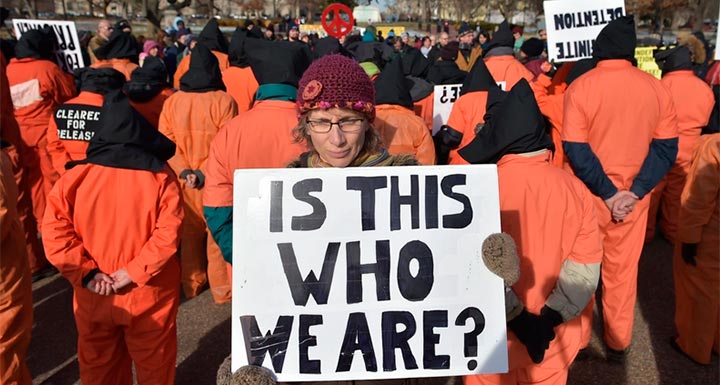
Guantanamo prison is wasteful and un-American. Shut it down
Before the “war on terror,” many Americans knew about Guantanamo Bay only from its depiction in “A Few Good Men.” In the film’s most famous scene, the Marine colonel who commands the U.S. naval base, played by Jack Nicholson, declares during a court-martial: “I have neither the time nor the inclination to explain myself to a man who rises and sleeps under the blanket of the very freedom that I provide and then questions the manner in which I provide it.”
We have been told that holding prisoners at Guantanamo for more than a decade is a necessary price for freedom. No matter what Nicholson’s character says, we can handle the truth, and the truth is that the prison in Cuba is a huge waste of taxpayer dollars, makes us less safe and runs contrary to our values as Americans.
In September, I visited Guantanamo to see how detainees were being treated and to better understand the costs of the operation. Walking around the dilapidated facility, I saw that Guantanamo is truly a relic, symbolizing a flawed strategy to house an ever-dwindling number of detainees.
Of the 779 detainees who have been held there, 657 have been transferred to the few countries willing to take them. The current population is down to 122 — 54 of whom are slated for release — but instead of closing the center, the Pentagon has asked for $290 million for building upgrades.
Holding a single prisoner at Guantanamo costs $3.3 million per year, more than 40 times the cost of holding a prisoner in a “supermax” prison in the United States. The logistical chain required to support the facility contributes to this price tag. A desalination plant provides water, but food and supplies must be shipped in. There are 2,268 staffers at Guantanamo, and medical personnel alone outnumber detainees.
Medical costs are a growing portion of facility costs. According to a New York Times report, when a detainee needed a stent, $1 million was spent on a mobile cardiac catheterization lab. The detainee refused the procedure, and the equipment was left to decay outdoors. When another detainee needed a kidney stone removed, the military imported a laser lithotripsy machine along with a urologist, all at massive expense to taxpayers. Such procedures will become only more complicated and expensive as these detainees age.
Why are detainees still being held at Guantanamo? Republicans continue to argue that it is the only facility capable of securely housing these dangerous men. At the detention center, I spoke to a military reservist who serves as a corrections officer at a state prison when not deployed. He said that the detainees at Guantanamo are much more docile than the population he normally deals with. We’ve entrusted custody of prisoners to 21 nations since 2001. Our supermax prisons are the most secure in the world. They’re more than equipped to securely house anyone.
Keeping terrorists in the federal prison system is not unprecedented. Omar Abdel-Rahman, “the blind sheik,” is serving a life sentence in North Carolina for his connection to the 1993 World Trade Center bombing. Only blocks from the Capitol, Ahmed Abu Khattala is being tried as a central suspect in the 2012 attack on the U.S. diplomatic mission at Benghazi, Libya. If convicted, he would serve his sentence in federal prison.
Those who seek to keep Guantanamo open also rely on false assertions and fears about detainees going “back to the fight.” But recidivism rates are low. Only 7 percent of the detainees released during the Obama administration were confirmed to have reengaged, compared with 19 percent during the Bush administration.
Meanwhile, Guantanamo has become a rallying cry for others to take up arms against the United States. The brutal interrogation techniques once used at the facility were well documented by the Senate intelligence committee’s report on CIA torture, and detainees on hunger strikes have been force-fed.
These brutal actions have fueled hatred abroad and provided potent imagery for terrorist propaganda spread by such groups as the Taliban and al-Qaeda in the Arabian Peninsula. Adm. Mike Mullen, the former chairman of the Joint Chiefs of Staff, called Guantanamo a “recruiting symbol” for terrorists and jihadists, which he saw as “the heart of the concern for Guantanamo’s continued existence.” Before beheading journalists James Foley and Steven Sotloff, the Islamic State evoked Guantanamo imagery by dressing the men in orange jumpsuits similar to those worn by detainees. The jumpsuit resonates in propaganda because it is so contrary to our values as Americans and has endured for more than a decade.
We need decisive action, and I applaud the steps President Obama has taken to reduce the prison population. But this wasn’t just his priority. In his autobiography, former president George W. Bush wrote that he had set “closing the prison at Guantanamo in a responsible way” as a goal for his second term. Unfortunately, this year’s National Defense Authorization Actcontinues to tie our president’s hands by preventing the transfer of prisoners to the mainland United States. Congress must end the status quo. We can’t wait another decade. We need to shut down Guantanamo.
* Jackie Speier, a Democrat, represents California’s 14th District in the House.
Photo: A protestor holds a placard questioning the American identity in front of hooded fellow protestors during a demonstration against the Guantanamo Bay detention facility on January 11, 2015. (Mandel Ngan/AFP/Getty Images)
(From: The Washington Post)

